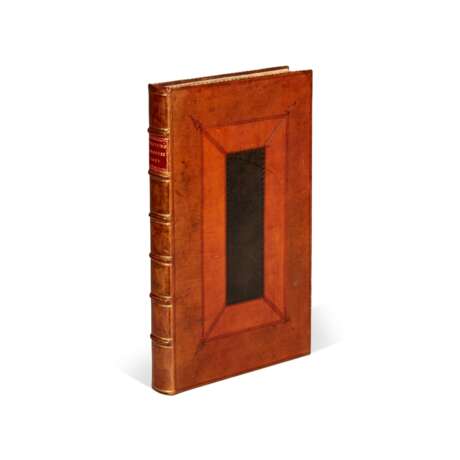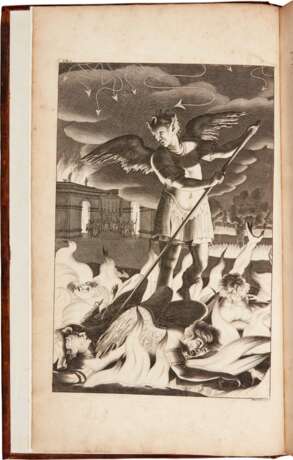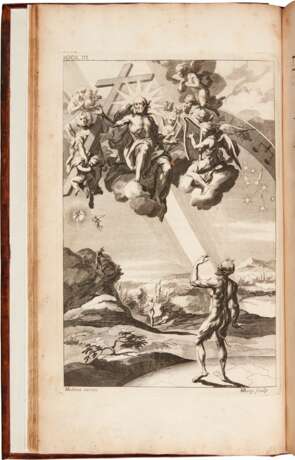ID 1076581
Lot 58 | John Milton | Paradise Lost. London, 1688, first illustrated edition
Estimate value
£ 5 000 – 7 000
Paradise Lost. A poem in twelve books. [and] Paradise regained. [and] Samson agonistes. London: Miles Flesher for Richard Bently [sic], 1688
Fourth edition, first folio edition, first illustrated edition, folio (398 x 235mm.), list of subscribers, engraved portrait frontispiece, 12 engraved plates, modern panelled calf in period style, portrait and title repaired, two plates with minor repairs to fore-edge (not affecting images), a few small stains or rust spots, final quire of last work a little foxed
A tall copy of the first folio appearance of Paradise Lost, adorned with memorable engravings. After the third printing, Milton’s widow parted with all further claims to the work for £8. The publication bargains continued when the printer Simmons then transferred all his rights to the poem in 1681 to Brabazon Aylmer for £25, and Aylmer subsequently sold half interests to Jacob Tonson and Richard Bentley, who together produced this sumptuous fourth printing of 1688, the first edition to appear in folio format and the first with illustrations. Most of the plates here were designed by a major artist, John Baptist Medina (1659-1710), a painter of Spanish origin who made his career in England and Scotland and was knighted for his talents. Medina, who was deeply influenced by the works of Rubens, did portraits, landscapes, and historical paintings, and the present illustrations are composed with sophistication and artistry on multiple levels.
All but two of the thirteen plates here are engraved by Michael Burghers (one of the edition’s subscribers), a Dutch-born artist who worked mainly in Oxford. Hodnett says in his Five Centuries of Book Illustration that the 1688 Tonson Milton is “the earliest serious effort to illustrate an important work of English poetry”, and in his work on Francis Barlow, he says our book is “the only major English literary work with important engraved illustrations in the 17th century.” John Harthan, in The Illustrated Book, says that the plate facing the opening of the text is “one of the most forceful of English seventeenth-century illustrations”.
According to Harthan, Susanna Boorsch in her study of the 1688 Paradise Lost argues persuasively that the four unsigned plates may have been the work of Dr Henry Aldrich, Dean of Christ Church, Oxford. In this copy, a bibliographical note in the margin of plate 12 confirms that: “This plate was executed from a design of Dr Aldrick, Dean of Christchurch Oxford. This Doctor Warton tole [sic] me at Winchester Nov. 1. 1782. & that he had this information from Havre, Canon of Windsor. Nov. 2. 82. J. Bowle”. It seems likely that our informant was literary editor John Bowle (1725-1788), who according to ODNB was recognised by Rev. John Douglas in “Milton Vindicated from the Charge of Plagiarism” for being “the ‘Original Detector’ of the spurious evidence adduced by William Lauder.” (Lauder had claimed in 1753 that Milton had plagiarized parts of “Paradise Lost” from no fewer than 97 authors, an absurd charge that was resolutely debunked.)
The first folio Milton was important in other ways, too: it was one of the first English books to be financed through subscription, bearing the names of more than 500 subscribers, including Dryden and Sir Paul Rycaut. This copy originally belonged to subscriber Ferrand Spence, who worked as a translator and editor. This strikingly illustrated—and consequently popular—folio printing went a long way toward helping to establish the reputation of Milton, whose Paradise Lost was relatively unknown when Tonson issued his edition and whose poem then appeared in more than 100 editions during the eighteenth century (more than twice the number of editions of Shakespeare’s plays).
Wither to Prior notes that Tonson “seems to have considered this publication his crowning effort, for in his portrait, painted by Kneller, he holds the book conspicuously in his hand.” The 1688 Paradise Lost often appears in the marketplace by itself, but the present volume also contains Paradise Regain’d and Samson Agonistes, both dated 1688
| Artist: | John Milton (1608 - 1674) |
|---|---|
| Auction house category: | Prints, graphics, books |
| Artist: | John Milton (1608 - 1674) |
|---|---|
| Auction house category: | Prints, graphics, books |
| Address of auction |
Sotheby´s 34-35 New Bond Street W1A 2AA London United Kingdom | |
|---|---|---|
| Preview |
| |
| Phone | +44 (0) 20 7293 5000 | |
| Phone | +1 212 606 7000 | |
| Conditions of purchase | Conditions of purchase |





